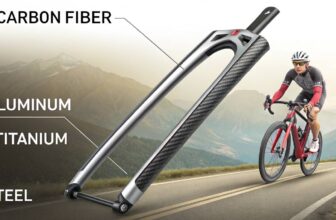Understanding Bottom Brackets
If you’re looking to level up your biking game, it’s time to get to know the backbone of your bike—yep, we’re talking about bottom brackets and their journey through the history of biking.
Evolution of Bottom Brackets
Back in the day, bottom brackets were like the old cars your grandpa used to tinker with—loaded with loose ball bearings that needed constant love and attention. Every ride felt like a gamble because let’s be honest, those things wore out like an old pair of sneakers (Cyclist). But hold on! The cycling fairy godmothers waved their wands, and ta-da!
Sealed cartridge bearings were born. These little wonders not only make the bike ride smoother but also cut down on the greasy mess of the past, making the cyclist’s life a whole lot easier.
| Era | Bearing Type | How Much Work? |
|---|---|---|
| Before 1980s | Loose Ball Bearings | A Ton |
| From 1980s Onwards | Sealed Cartridge Bearings | Hardly Any |
Then came a time when bike frames started hitting the gym. They bulked up to make room for all the new tech, including bigger bearings that play nice with all those fancy, lightweight chainsets out there. Light and stiff is the name of the game now, making every pedal push count (Cyclist).
Significance of Bottom Brackets
Now, you might not give a second thought to what’s happening down by your feet while cycling, but bottom brackets? They’re the unsung heroes making sure everything spins like a ballet dancer. Their job is to keep the crankset turning like butter, ensuring that every ounce of energy you pump out hits the wheels hard (Cyclocross Magazine). You can think of them as the quiet powerhouses keeping everything snappy and efficient.
Traditionally, two main camps existed: BSA or British Standard Cycle, and its flamboyant cousin, the Italian threaded standard. The British one was the go-to for steel frames, lean and mean with a 68mm width and 34.8mm girth (Cycling Weekly). The Italian version was the slightly chubbier kid on the block, with its own thread flair on both ends.
These days, there are three big players in the bottom bracket scene. You’ve got your PressFit, your Threaded, and your smooth Thread-Thru variations. Each has its own quirks and setups, making sure there’s something for every bike and every biker’s vibe (Up.bike).
So, getting a handle on this bike tech is gonna make you the savvy cyclist you dreamed of being. If you’re all about keeping your ride in top form, swing by our road bike maintenance section for some pro tips.
Modern Bottom Bracket Systems
Picking the right bottom bracket for your road bike can change everything about how you ride. We’re breaking down the basics for three popular options: Sealed Cartridge Bearings, Hollowtech System, and Ceramic Bearings.
Sealed Cartridge Bearings
These have pretty much taken over the world of road bikes. Unlike the old-school loose ball bearings your grandpa might remember, these guys are all about simplicity. They’re easy to swap out and they keep the grime and water at bay. But heads up, you can’t fix them, and they usually bow out after about a year if you’re racking up some serious miles.
| Feature | Description |
|---|---|
| Serviceability | Nope, gotta replace them |
| Lifespan | About a year, depends on how much you ride |
| Protection | Sealed tight against dirt and dampness |
Need a hand keeping these in shape? Check out our tips over at road bike maintenance.
Hollowtech System
Shimano fans, this one’s for you. The Hollowtech system’s pretty much a staple for bikes rocking Shimano parts. You’ve got this big hollow spindle that’s locked onto the drive-side crankarm fitting into a standard thread. It’s all about being stiff and transferring power, which is why it’s a hit with many cyclists.
What makes this system a crowd-pleaser? It’s light, stiff, and super simple to set up. Nail the preload game to keep things smooth. Dive into preload adjustment to get the best out of your Hollowtech setup.
Ceramic Bearings
Now, if you’re chasing that dream ride, ceramic bearings might be your jam. Ditch the steel for ceramics which are all about being light, tough, and smoother than a jazz sax solo.
While the debate rages on about whether they outlast steel, one thing’s for sure: ceramic bearings can cut down friction, giving you that extra edge—perfect for races or epic rides.
| Feature | Ceramic Bearings | Steel Bearings |
|---|---|---|
| Material | Ceramic | Steel |
| Friction | Less | More |
| Weight | Lesser | More standard |
| Lifespan | Could hang on longer | Bows out faster |
Wanna know more? Our deep dive into ceramic vs. steel bearings should clear things up.
Getting to grips with these bottom bracket systems means you’ll find the perfect fit for your biking adventures. Whether you’re gunning for gold or just out for a Sunday pedal, find more bike wisdom in our guides on road bike gears and bike chain care.
Bottom Bracket Maintenance
Keeping your road bike’s bottom bracket in tip-top shape is key for a ride that feels like a breeze. Knowing when to give it some TLC can spare you from surprise breakdowns and help your bike feel as fresh as a daisy.
Indications for Replacement
The bottom brackets are the unsung heroes of cycling, quietly keeping you on the move. When they start to give up the ghost, you’ll notice:
- Annoying grinding or creaking sounds underfoot
- A wobbly or loose feel with each pedal stroke
- That uh-oh moment when your pedals just don’t spin smoothly
Modern bikes typically come with sealed cartridge bearings that are like a one-shot espresso—great while they last, but you can’t refill ’em. Most folks find they get thousands of miles before it’s time to swap them out, usually around every year or two.
Importance of Regular Maintenance
Giving your bottom bracket a little love can really stretch its lifespan. If you’re tackling rainy, muddy rides, or other challenging conditions, it’s worth paying more attention to avoid wasting parts prematurely. Get in the habit of:
- Checking for gunk buildup
- Keeping an ear out for unusual sounds during your jaunts
- Dabbling some grease where needed to keep things slick
- Making sure everything’s joined together nicely
Regular care is your bottom bracket’s best friend and should be a regular pitstop in your bike check-ups.
Ceramic vs. Steel Bearings
Picking between ceramic and steel bearings is like choosing between a sports car and a trusty pickup—both get you where you need to go, but the ride can feel different.
| Factor | Ceramic Bearings | Steel Bearings |
|---|---|---|
| Longevity | Great in clean conditions | Decent in rough spots |
| Ride Feel | Super smooth, less resistance | Solid, but a bit more friction |
| Upkeep | Minimal | A tad more often |
| Price Tag | Steeper | Wallet-friendly |
Ceramic’s the fancy-schmancy option—less friction, longer-lasting—but with a price tag to match. Steel’s the go-to for most, striking a solid balance between performance and budget. Whatever your choice, proper upkeep is the ticket to a long, happy life.
For more advice on taking care of your bike, check out Road Bike Chain Care.
Want to keep the rest of your bike purring along as well?
- Road bike brakes
- Road bike tire change
- Road bike cleaning
- Road bike tools list
By keeping up with maintenance, knowing when things need a refresh, and picking the right parts, you’ll be gliding down the road every time, just like riding a freshly tuned bike was meant to feel.
Bottom Bracket Standards
Picking the right bottom bracket for your road bike is a big deal if you want your ride to purr like a kitten and avoid any nasty surprises. We’ll break down the nuts and bolts of the whole bottom bracket business, covering shell sizes, threaded options, and those sneaky PressFit ones.
Standardized Shell Sizes
First thing’s first: shell size. Road bikes typically swagger around with a 68 mm shell size—a crowd favorite since the mid-90s! If you’re rocking an Italian road bike, you might be looking at a 70 mm deal. Mountain bikers from way back? 73 mm. Fancy yourself a downhill daredevil? You need the hefty 83 mm. And if you’re braving snow on a bike, you’re in the 100 mm club (Wikipedia).
| Bike Type | Shell Size (mm) |
|---|---|
| Road Bikes | 68 |
| Italian Road Bikes | 70 |
| Early Mountain Bikes | 73 |
| Downhill Bikes | 83 |
| Snow Bikes | 100 |
Knowing these sizes saves you from the headache of a mismatch when you’re swapping or upgrading parts.
Threaded Bottom Brackets
Threaded bottom brackets have been strutting back into the limelight. Recently, around 2020 and 2021, top dogs like Trek and Specialized embraced the old-school charm of T47 and BSA standards for fresh models like the Tarmac SL7 and Aethos (Cycling Weekly).
Why are folks digging them again? Well, they’re super easy to manage, even if you’re a DIY mechanic on the weekend. They’re also quieter, so you won’t hear a peep from those annoying creaks. Just a solid, dependable choice for those who like wrenching on their bikes at home.
PressFit Bottom Brackets
SRAM rolled out the PressFit bottom brackets in 2009 to shake things up a bit. Their PressFit 30 (PF30) aimed to cut costs and dodge some tolerance hiccups they’d noticed with BB30. This system uses nifty composite cups that make the frame-building process less of a pain and add bonus points for the integrated seals which help your bearings live longer (Bike Radar).
These bad boys are lighter than their threaded cousins and are a breeze to install. But, they might ask you to show them some love more often—so keep the maintenance routine lively.
| Bottom Bracket Type | What They Offer |
|---|---|
| Threaded | Easy DIY fix, robust, heavier, less noise |
| PressFit | Simple fit, featherweight, adds life to bearings, but needy about care |
Want more tips on keeping your ride smooth? Check out our guide on road bike maintenance. Nailing the right fit when it comes to your bottom bracket means more miles of fun and fewer pit stops for repairs!
Recent Innovations in Bottom Brackets
In the speedy lane of bike tech, bottom brackets are getting a snazzy makeover to boost performance, stick around longer, and play nice with other parts. Let’s check out the new cool kids on the block: T47 Bottom Bracket Standard, SRAM DUB, BBRight, and BB386Evo systems.
T47 Bottom Bracket Standard
Back in 2015, the T47 bottom bracket rolled in like a superstar, combining the big axle vibe of PressFit with the dependable nature of threaded brackets. We’re talking a 46mm internal diameter, kind of like the PressFit 30, but instead of getting shoved in, it threads in right where it belongs. This little tweak helps squash those annoying creaks you get with other big press-fit setups, while keeping things nice and sturdy (source: Bike Radar).
| Feature | T47 Bottom Bracket |
|---|---|
| Internal Diameter | 46mm |
| Installation | Threaded |
| Key Benefit | Bans creaking issues |
SRAM DUB Bottom Bracket
Popping onto the scene in 2019, the SRAM DUB (Standing for “Durable, Unifying Bottom Bracket” natch) has a cool 28.99mm spindle diameter. This system is like the Swiss Army knife of bottom brackets, getting cozy with multiple setups like BSA threaded, PF86, PF92, BB30 (73mm shell), and PF30 (73mm shell) (source: BikeRadar). It’s all about keeping things simple for builders and mechanics, fitting in lots of frame styles.
| Feature | SRAM DUB Bottom Bracket |
|---|---|
| Spindle Diameter | 28.99mm |
| Compatibility | BSA, PF86, PF92, BB30, PF30 |
| Key Benefit | Plays well with others |
BBRight and BB386Evo
The BBRight setup learns a thing or two from PF30 with its 30mm spindle and cartridge bearings but moves the non-driveside bearing out by 11mm. The wider shell adds some muscle to the frame, especially where it counts like the downtube and chainstays (source: Bike Radar).
| Feature | BBRight |
|---|---|
| Spindle Diameter | 30mm |
| Bearing Location | Scooted out |
| Key Benefit | More muscle |
On the flip side, BB386Evo is all about being flexible, letting in both 30mm and 24mm spindle diameters. Thanks to its wide shell, it means business with pedal efficiency and power transfer.
Hungry for more bike know-how? Check out our insights on road bike crankset types and boost your skills with road cycling techniques.
When you wrap your head around these snazzy bottom bracket updates, it’s your passport to pimping out your ride, whether you’re fresh on the path or a seasoned vet. For even more tips and tricks on taking care of your bottom bracket, dive into our helpful road bike maintenance guide.
Bottom Bracket Compatibility
Knowing how to choose the right bottom bracket can spell the difference between cruising smoothly on your road bike or stopping more often than you’d like. Get a handle on how to match those cranky cranks, deal with preload adjustment, and decide between ceramic and stainless steel bearings.
Matching Bottom Brackets with Cranks
Picking out the right bottom bracket for your cranks is like picking out the perfect pair of shoes—they gotta fit just right! Let’s break it down by spindle diameters:
- 30mm Spindle Diameter: Got cranks like eeWings? This means you match them with a 30mm bearing.
- 29mm Spindle Diameter: Sporting SRAM Dub cranks? Go for a 29mm Hellbender 70 bottom bracket.
- 24mm Spindle Diameter: Shimmy with Shimano and its 24mm spindles? You’ll need a 24mm Hellbender 70 bottom bracket.
To help visualize:
| Spindle Diameter | Bottom Bracket Type | Crankset Example |
|---|---|---|
| 30mm | 30mm Bearing | eeWings |
| 29mm | 29mm Hellbender 70 Bottom Bracket | SRAM Dub |
| 24mm | 24mm Hellbender 70 Bottom Bracket | Shimano |
When your crank and bottom bracket are best pals, it brings life to your ride. Curious for more cranky tales? Check out road bike crankset types.
Preload Adjustment
Preload adjustment sounds fancy but it’s really just about tightening up a bit, so those bearings don’t throw a tantrum. Ignore it and you’ll find your ride calling it quits way earlier than you’d planned.
- Initial Setup: When setting up, follow what the manufacturer says—don’t wing it.
- Regular Checks: Every now and then, give your preload settings a check, just like spying on the neighbor’s mower maintenance.
- Adjustment Tools: Got the right tools? You know you do. Use ‘em to keep your setup cool.
Keeping your bike ready to roll is a cinch with tips from our road bike maintenance article.
Ceramic vs. Stainless Steel Bearings
Choosing between ceramic and stainless steel bearings, huh? Kinda like choosing between a sports car and a trusty pickup. Both have their perks!
- Ceramic Bearings: These little round guys offer endurance with less rolling resistance. Perfect if you’re chasing seconds in a race and don’t want rain or corrosion slowing you down.
- Stainless Steel Bearings: Tough as nails and just as long-lasting, these bearings are like weekend homies, ready for endurance and long rides without a hitch.
It’s comparison time!
| Type of Bearing | Durability | Rolling Resistance | Corrosion Resistance | Perfect For |
|---|---|---|---|---|
| Ceramic Bearings | High | Low | High | Competitive Racers |
| Stainless Steel Bearings | Medium | Medium | High | Endurance Riders |
Figuring out what’s best? Think about how you ride and how often you like to play mechanic. More deets in our road bike components guide.
Grasping the basics of bottom bracket compatibility, sprinkling in some preload know-how, and picking the right bearings, opens up a path to smooth, joyful rides. Want to dig deeper into bikes and parts? Slide over to our road bike maintenance secrets section.




